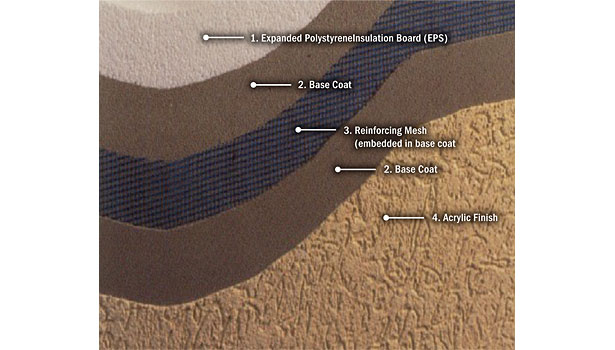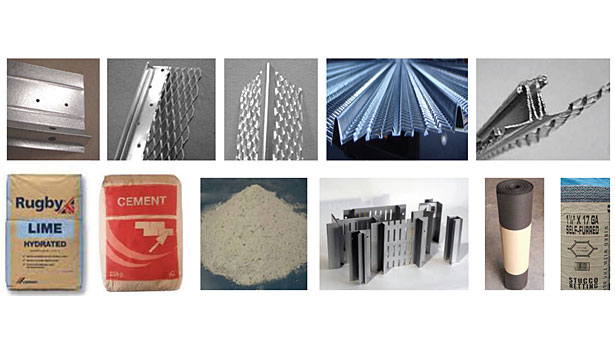Rolling Along

Four Basic EIFS Components

Left to right, top; Weep screed, Casing bead, Cornerbead, Rib lath, Control joint. Bottom: Lime, Cement, Sand, Metal reveals, Water resistive barrier, Stucco netting


Probably one of the most extensively tested exterior claddings is Exterior Insulation and Finish System or EIFS. (An acronym pronounced “eefs,” please don’t call it EFUS.) When you look at the basic components of an EIF system, you can see the simple design and minimal amount of parts required to complete this system. All of these parts fall under the warranty umbrella of one manufacturer and all are designed to be synergistic, operating as one unit, a system. However, the simplistic nature of EIFS may in fact be what concerns wary design professionals and contractors.
STUCCO REIGNS KING OR DOES IT?
One of the most challenging market areas for EIFS is the stucco capitol of Southern California. The preferred cladding of choice is the three-coat stucco system. Most of the plastering contractors there can apply stucco in their sleep. Southern California has some of the finest stucco mechanics in the industry, clean, fast, and extremely efficient. There is a fair amount of EIFS applied there, but overall, stucco reigns king. One might even go as far to say that there is a disregard or lack of confidence in the EIFS claddings. This extremely challenging EIFS market is mirrored, on a much smaller scale, throughout the US.
Barrier EIFS uses four basic “parts”; expanded polystyrene, acrylic modified base coat, woven fiberglass mesh and an acrylic finish. It is a true “system” and as mentioned before carries an “umbrella,” or single source warranty. Stucco uses many parts and pieces: a code approved water barrier, self-furred metal lath, corrosive resistant fasteners, galvanized metal or vinyl trims, cement, lime, sand and sometimes an acrylic finish or a paint coating. Stucco installed is an assembly and the warranty falls to the local building code terms or the contractor. An exception to this is the newer proprietary stucco mixes, which can carry a manufacturer’s warranty. EIFS can be applied in a short span of three days, stucco a minimum of seven. Both claddings keep out the weather while providing an aesthetically pleasing finished look. Both have been around for a long time.
Many years ago, a leading EIFS manufacturer produced an EIFS installation tape which compared EIFS to a fine guitar. The guitar was built with hand crafted excellence that provided many years of service and musical pleasure. In comparison, the EIF system was a manufactured excellence that, as a system, provided many years of aesthetic appeal, thermal performance, and occupant comfort. The comparison was fitting at the time when EIFS was applied by an elite group of plastering professionals. EIFS applicators were limited and considered specialists during the early years of EIFS. Now EIFS is applied by most plastering firms, and the select group of “certified” applicators is but a memory. The excellence in application is still there, but because EIFS is so widespread, it may have lost some of the craft mystique it once had. Since stucco has been around since the Egyptian days, it is a natural “I know it, I’m comfortable with it,” fall-back option.
The installation VHS tape was very well done and appropriate back then. However in today’s market, EIFS might be better compared to a bicycle than a guitar. Like the simplicity of EIFS, the bicycle is a very basic means of transportation. Push down on a pedal and the machine is propelled forward, pedal backward and it stops. The hardest part of learning to ride a bicycle is the balance aspect. The very simple function of the bicycle is to get you from point A to point B. Although very simple, a bicycle has hidden benefits. While pedaling from point A to point B, the rider is exercising and getting healthier. The man-power propulsion of a bicycle helps to reduce the carbon emissions spewed into the air from the automobile. Sure it may take longer to get to a destination on a bike vs. a car, but the rider is able to enjoy the outdoors, and take in all the sights and beauty the slower pace has to offer.
HIDDEN BENEFITS
An EIF systems’ basic function is to keep the weather out of a wall assembly. It is also a good looking exterior cladding that can replicate stucco, brick, metal or even wood. EIFS has hidden benefits, in that it functions as a system to provide continuous insulation around a building. This silent performance helps to maintain a constant interior temperature, lowering the demand for energy to heat or cool the building. It too helps our environment by reducing carbon emissions. Both the bicycle and EIFs have been around for many years functioning in their simplicity and providing “silent” benefits.
It is acknowledged that there was a big scare about some water intrusion issues and EIFS claddings some years ago, and it contributed to some intense scrutiny of the cladding. Like the bicycle rider who fell off their bike and broke both arms, and who vowed to never ride a bike again, there exists the designer or contractor who may have gotten into some hot water with their EIFS cladding and vowed to never use EIFS again.
This article is written to tell you that EIFS is a superior, high performance cladding, and there is no need to fear it. Yes, there were some concerns about moisture intrusion, but through a very intense scrutiny of the EIFS claddings it was brought to light that the “perceived system failures,” were nothing more than improper detailing and improper installation. In fact, despite the application wrong doings, the EIFS claddings had performed very well. The instances were limited to small areas like directly under windows, at below grade terminations or at roof run-off points. The EIFS moisture intrusion issues were sensationalized to make good press. In fact, other claddings were experiencing the same moisture intrusion issues but didn’t make the news, were never brought to light, and were written off as an unfortunate occurrence.
So, back to the comparison to a bicycle, let’s say you wanted to ride your bicycle off road over very rough terrain, up one mountain and down another. Your simple “old school” ride would make your venture challenging. You might think, “there has got to be a better bike for this,” and there is. You’d go to your local bike shop and get a mountain bike with many gears, a more comfortable seat and a shock absorbing suspension, a higher performance bicycle for higher performance riding.
EIFS barrier systems are the flagship design and are the simplest of the systems, the “old school” cladding. For a higher performance system you could add a drainage plane with a monolithic secondary water resistive barrier or even make the EIFS cladding a pressure equalized system. Maybe you’d want to add a finish with special technology that has the ability to shed dirt and grime. When you add these to a standard EIF system, you enhance them with a belt-and-suspenders performance system. Although enhanced EIF systems are available, like the basic “old school” bike, barrier EIFS still performs as intended and should not be excluded. Considering its simplicity, the performance characteristics of EIFS claddings are very high.
USE COMMON SENSE WITH EIFS
Despite what an EIFS salesperson may tell you, the truth is that EIFS may not be practical in some applications. Heck, you could ride your bicycle in the fast lane of the busy boulevard during rush hour if you really wanted to but c’mon, really, would you? Or roll down the big hill with no hands on the handlebars, head back, eyes closed, wind in your hair, risky. Likewise there are building locations and elevations where EIFS really shouldn’t be considered. For example; an EIF system should not really be used on a parapet top. Any horizontal surface should not be larger than 18 to 24 inches wide, else it becomes a roof. Don’t allow the system to continue below grade where hydrostatic pressure could cause water to get in, or bugs could find a hidden path into the wall assembly. Consider other cladding options for shopping center columns at the end of the parking spaces. And as was learned from experience with EIFS on schools, maybe consider brick, or stone, or titanium, as the cladding. Knowing the limits and keeping it practical can only lead to success.
WHERE EIFS MAKES SENSE
With the new energy code mandates, we will see a more prevalent use of continuous exterior insulation. The Western Conference of Wall and Ceiling Institutes developed a brochure titled “How to Make Continuous Insulation Work, The Energy Code and Plaster Assemblies.” It illustrates EIFS, one-coat stucco, and three different three-coat stucco systems, with foam insulation. EIFS of course was founded on the exterior insulation concept and is the first choice. One-coat stucco, another cladding option, has for many years been applied over one inch tongue and groove EPS and has CI benefits. It is the three-coat stucco, applied over foam systems, that are still relatively an unknown concept. When you compare the different systems, EIFS just makes sense. It is a proven system with extensive testing. EIFS weighs just one pound per square foot, can be applied to the finished product in three days, is easy to install and uses just four basic components. Stucco still remains a very popular and effective cladding, but when considering exterior continuous insulation systems, there is no need to re-invent the wheel.
There are many myths and misguided understandings about EIFS. A true understanding of these systems can alleviate concerns or misunderstandings about EIFS. You can contact your local EIFS representative for an educational seminar or to simply ask questions about the systems and their performance. Local trade associations are another avenue for cladding information. In these slow construction times and with increased competition, why spend your valuable time figuring out how to make an unfamiliar system work. Have faith in the proven system called EIFS, and get back up on your bike and cruise the boulevard. Enjoy the simple pleasure a good ride brings, and yes, roll with EIFS. W&C
Looking for a reprint of this article?
From high-res PDFs to custom plaques, order your copy today!







